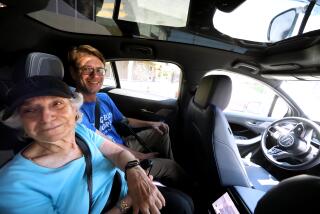It tells you your rights
Navigating a rental car to a business appointment in a strange city is a challenge for even the most directionally gifted drivers. Our thoughts are often more on what curves lie ahead at a meeting than on what’s around the next bend in the road. Tussling with maps or directions can be frustrating and dangerous
Rental car giants Avis and Hertz have introduced optional navigational devices for their rental car fleets in many major markets. They cost $9.95 a day for Avis, $9 for Hertz -- on top of the price of the rental car.
The Avis Assist and Hertz NeverLost systems rely on the same basic street-mapping data (provided by Chicago-based NavTeq Corp., which also supplies data to online mapping services such as Yahoo Maps) and satellite positioning technology. Yet how those data are deciphered and presented to drivers are poles apart.
I arranged to put these competing devices to the test last month on a drive around Los Angeles, ranked the seventh-worst city for driving by Sperling’s Best Places. (Boston topped the list.)
The NeverLost device is permanently mounted in the rental car, so Hertz provided me with a car for a day. To help take notes safely while driving and using the gadgets, my friend Mike volunteered to be my scribe.
I plotted a route that a typical business traveler visiting Los Angeles might take, leaving LAX for downtown, then on to an office building in Glendale, back to the Long Beach Convention Center and returning to LAX.
My first stop was at the Avis office at LAX, where I was issued my Avis Assist device, a specially modified Motorola cellphone. An Avis representative gave me a brief introduction to the device, just as any renter would receive. We called the Avis Assist operator, who programmed my destinations into the system directory in less than three minutes.
At Hertz, I was given a brief introduction to NeverLost. The device must be manually programmed, but once I got the hang of the toggle switches, it was clear-cut and about as fast as programming Avis Assist.
I installed Avis Assist on the inside of the windshield, positioning it so I could see it and NeverLost, which was mounted just to the right of the center console, at the same time.
As we pulled out of the Hertz lot with both devices switched on, the first predicament surfaced. “Turn right,” instructed a disembodied, though pleasant, female voice.
“Which one said that?” I asked my scribe. After some careful listening, we deduced that NeverLost was a female voice, Avis Assist a male. It was the male voice that would give us our first surprise.
“In a quarter-mile, turn right on garble-garble,” said Avis Assist in its scratchy male voice.
Huh?
“Turn sharp right on garble-garble,” it repeated.
Because we were approaching La Tijera Boulevard, we were left to figure out that the electronic voice just wasn’t very good with some Spanish words, a potential problem in a city filled with streets such as La Tijera and La Cienega. We followed our interpretation of its advice and turned right on La Tijera.
At the 405 Freeway, we encountered our first fork in directions. NeverLost wanted us to get on the freeway going north, a perfectly sensible direction. Avis Assist was sending us to La Cienega, a more direct route on city streets, also a perfectly sensible route, and one that a savvy Angeleno might take.
Although both devices use the same street-map data, there is more than one way to get from Point A to Point B. The Hertz system gives the user some latitude and allows one to choose “shortest time,” “most use of freeways” or “least use of freeways.” Avis Assist is preprogrammed to pick the “optimal” route, unless the user tells the Avis Assist operator otherwise.
I find a certain comfort in being on a freeway in a strange city, so we took the 405, curious to see how Avis Assist would react. It noted we were off our route, so we hit the recalculate button and it smartly put us on the same course as NeverLost -- rather than trying to get us back on its originally plotted course.
An easy, late-morning cruise along the 405 and 10 freeways gave me a chance to note to my trusty assistant some of the fundamental differences between the devices.
Avis Assist, although still sometimes difficult to understand on the cellphone speaker, gave very specific spoken directions, such as “Bear left on I-405,” but provided very little graphic detail on the small, black-and-white LCD display.
By contrast, NeverLost provided generic, easily understood spoken directions, not mentioning the names of streets or freeways (“Bear left,” for example, without mentioning the freeway designation), but provided the street names and excellent map detail on its larger, easy-to-read, multicolor display.
As we merged onto the north 110 Freeway in downtown Los Angeles, all was going well until Avis Assist announced: “In one mile, take the exit to go onto U.S. 101 south.” The problem? Three signs pointed to various exits, but none was for the 101 south.
At this stretch of L.A. freeway madness, the 101 continues through downtown and becomes either the 10 or the 5 Freeway. But the signage at this juncture of freeways only indicates an exit to I-10/I-5, not 101 south. Whether NeverLost got it right or not, I’m not sure, because neither of us glanced down at it at that moment. It was just generically chirping to exit to the right, though there were two right exits.
I later asked Hertz and Avis if they ever sent out employees to test-drive the devices to catch issues such as this. They said they did, to varying degrees, but noted that every possible route cannot be tested. Both rely on NavTeq to keep the map data current. Yet when I did the same route on Yahoo Maps, also using NavTeq data, it got it right.
After a brief rest stop downtown to collect our thoughts and jot some notes, we were on our way to Glendale. On our way, we encountered another fork in the road and, this time, took Avis Assist’s advice. NeverLost automatically recalculated our route and duplicated the Avis directions. The rest of our driving adventure revealed some of the quirks of using the devices. Avis Assist insisted we exit at Sanchez Drive in Glendale, which is not an exit. (It is a frontage road that merges to Brand Boulevard, our destination.)
In Glendale, we used both devices to help us plot the nearest place for lunch. Avis Assist has a Yellow Pages listing of restaurants. NeverLost has the option of a Yellow Pages listing as well as access to the AAA Tour Book listings, which rate restaurants besides providing addresses and phone information. I was keen on the Burger King half a mile away, but my scribe had been promised lunch as payment for his services and chose Far Niente, an Italian restaurant on Brand Boulevard.
It was in finding the restaurant that NeverLost got me momentarily lost. Because I was paying more attention to the directions on the map and the woman’s smoothly confident voice than to the actual address, I drove right past the restaurant and ended up around the corner. I had to look again at the address and backtrack a bit. NeverLost wasn’t exactly wrong, but it wasn’t exactly right, either.
My final leg was ultimately doomed by our longer-than-expected lunch, which necessitated that I return my helper home to West Hollywood for an appointment. A 2:30 p.m. Thursday sobriety checkpoint in Beverly Hills snarled traffic for blocks, and a parking lot of a 405 Freeway heading toward Long Beach changed a 10-minute drive into an hour-plus.
Having promised to return the rental car that afternoon, and having learned what I had set out to learn about the differences between the two systems, I reversed course about four miles from LAX and called it a day.
For me, the winner, if it can be called that, was Hertz NeverLost. I liked that I could easily refer to the map and know my exact location and direction of travel in relation to the streets around me. I also found “her” voice easier to understand than “his.”
But for drivers who want more specific spoken directions and don’t want to glance at a map, Avis Assist is a good option that also may be a bit easier for some to program.
Avis Assist is like having someone next to you in the car reading a map and telling you exactly where to turn. Hertz NeverLost is like having someone telling you what you are about to do, and if you need more information, you need to glance at the map.
Because people process information differently, there is no “better” way in my estimation. If you tend to process oral information better, the Avis Assist might be for you. If you like having a detailed map to glance at for reassurance that you are on the right track, NeverLost might be the better option.
Neither system was perfect. I expected to be relieved of having to worry about where I was. The reality is that both lend a hand, perhaps leaving you with one more hand on the wheel, where it should be.
If you do get lost, the devices are pretty smart about getting you back on track. And it’s pretty hard to find anything these days that’ll do that for just 10 bucks.
*
(BEGIN TEXT OF INFOBOX)
The particulars
Comparing the computer navigation systems for Avis and Hertz rental cars:
*--* Avis Hertz Cost per day $9.95 $9
*--*
*--* Programming Phone Manually
*--*
*--* Data source NavTeq NavTeq
*--*
*--* Voice Male Female
*--*
*--* Display B&W; Color
*--*
*--* Restaurant information Yellow Pages Yellow Pages/AAA
*--*
*
Final word ...
Avis: Like a human navigator.
Hertz: Just follow the treasure map.
Sources: Hertz and Avis
More to Read
Sign up for The Wild
We’ll help you find the best places to hike, bike and run, as well as the perfect silent spots for meditation and yoga.
You may occasionally receive promotional content from the Los Angeles Times.






